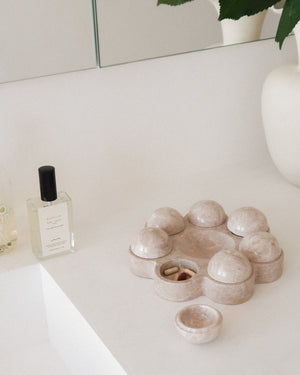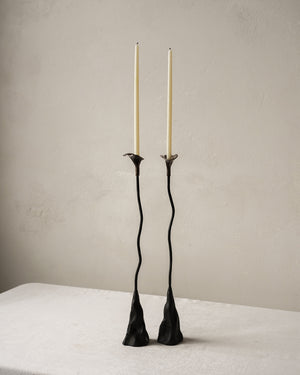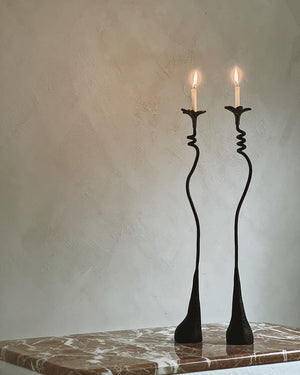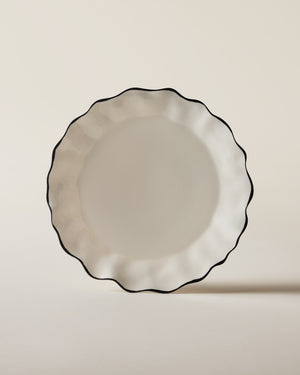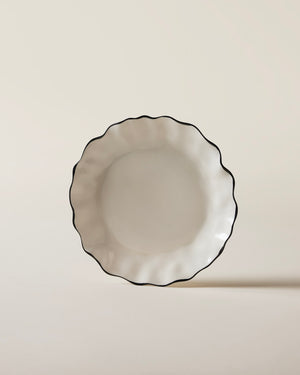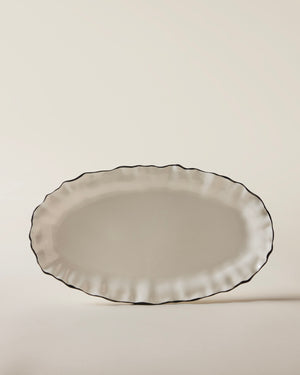LIVING WITH LATCH KEY

Photography by Hannah Thornhill
Today at LES, we delve into the world of ceramics and unconventional studios with Whitney Sharpe whose deep passion for raw clay, function, and community shows in her work. Based in Oakland, CA, Sharpe's intuitive artistic style is reflected in her one of a kind pieces with her signature chain feature and natural toned colors. Through her personal art practice, she explores the relational and ritual aspect of materiality by challenging the imitations of medium and skill. Sharpe is always in conversation with her medium, recognizing the connection between her hands and the clay. Learn more about Sharpe and how her functional studio she shares with other creatives inspires her every day.

1. We are so excited to get the “behind the scenes” of your studio. What was your main source of inspiration for designing your studio?
Function! I moved into this ground floor studio 5 years ago and wanted separate stations with plenty of storage. At the time, I was making ceramic jewelry and wall hangings with shipping as a huge component. I have my studio set up with stations around the perimeter and my main work table in the center. I designed the shelving and my partner, who is a woodworker. He brought my designs to life, installing the shelving and lower bench.
2. What does a day in your studio look like? And how did you come up with the name "Latch Key"?
Ceramics is very similar to cooking; timing is of the utmost importance as well as quality ingredients. Think of making your favorite pasta from scratch; the multi step process is part of the specialty, luxury and ultimate success of the meal. It's organized chaos, just as my studio days are. Everyday is different. When I am ready to start working, I prep my hands with a moisturizing massage to warm them up, using my favorite beeswax salve. I light a candle and set my intention for the day, sometimes needing a moment of meditation and others breezing through into production. I check on yesterday's pieces to ensure they are at a suitable dryness, either securely covering them or arranging them to dry more. This is my relationship to clay, one must pay attention to what the material is communicating and make decisive changes if needed.
Then to prepare materials; roll out slabs and pull coils to later be utilized for building new pieces. I usually work on 4-10 pieces at a time, allowing the clay to dry while I work on the others. If I am starting a new collection, it looks something like this: Cut all bases from the slab, add one to a turning wheel and begin the process of building, pinch by pinch until the clay communicates that it's had enough. Then start on another piece until you’ve completed all of the bases cut for the first phase of building. When you've completed the first stage, usually the piece you built first is ready to add the second tier of construction. Drying time is key! Before beginning the second phase, check on yesterday's components, tying them in plastic, which is like stopping time in terms of drying. Maybe unload the kiln, stretch your shoulders and get back to building. Once the second phase is completed, look at your components and decide if it's time to add the accoutrement to yesterday's pieces.
I came up with the name 11 years ago. Latch Key came from the concept that my creative practice was born as a means to combat time spent alone. “Latch Key Kid” is a kid who has a key to their house and lets themselves in after school and is responsible for their own care until their parents are home from work. My art practice was an entry to my creative world to utilize this time. I grew up in a rural lake town in Michigan and spent a lot of time alone, finding solace in painting, writing and clay. As my work has grown and my focus shifted, I have struggled with outgrowing this name as it doesn’t quite fit. Also who wants to talk about their childhood when focused on the present? Brand identity is strong and now I am attempting to shift the focus from Latch Key to my given name, Whitney Sharpe.
|
Cora Vessel Whitney Sharpe |
Black Sheep Vessel Whitney Sharpe |

3. We are so intrigued by your unconventional studio, Standard Parts Studio, that you opened with fellow artists. How did this idea come about and how is it working in a communal studio with other creatives?
When you have limited resources, you become creative with what you do have. I was living in a 2400 sqft warehouse in Oakland with friends that we’d built out a few years before. It was a wild place where we would have music shows and turn into a speakeasy to make rent or sell our vintage finds outside of the roll up door. I started Latch Key in an unused corner of that building, eventually outgrowing it and needing separation. The same owner of this building also owned Standard Parts and offered it to me. It's a 6500 sqft multi unit industrial building with natural separation. As soon as I saw the building, I knew it was the perfect place to host multi disciplinary artists, not just a quiet corner for myself. Plans shifted, conversations were had and our community showed up big time.
We were a crew of artists, musicians and builders. Skill sharing and work parties made it happen. It was a huge undertaking, all of my life's savings and about a year of preparation. Renting it out was easy, the community I am a part of also needed space to work. That was almost 8 years ago and some folks have moved on while new artists are moving in. It's always in flux, which is the beauty of each moment. I’ve just gotten word the building is coming up for sale, who knows what the future holds. Either way, I hope to continue to foster a creative community.
Working alongside other artists is the dream; to be able to have a quick critique or pep talk, nerd out on different techniques and have community in the age of isolation grounds me. There are of course downsides to having a group of highly perceptive and sensitive people but ultimately it's a touchstone for creativity.
4. Do you have any studio must haves? A podcast? Playlist? Snacks?
I am always listening to something; I prefer ambient music to focus but also have my go to podcasts. I listen to a lot of audio stories around mythology which are a great source of inspiration. My forever snack is a mix of nuts high in omegas which I usually need to keep me going in the afternoon.

|
Mishka Vessel Whitney Sharpe |
T.E. Vessel Whitney Sharpe |
5. Many artists and creators consider the place where they create as important as the final artwork. Do you find that your studio is a haven that inspires you to produce your best work? Why or why not?
My studio is a place of great importance in my life but I do not think I do my best work because of that specific location. Rather, my “best work” is more about where the work is coming from within myself. My studio is known, comfortable, reliable, a place of magic. I attempt to do an annual self imposed residency to make work outside of my studio. It's freeing to create pieces that have nothing to do with my usual work.
6. How would you describe your artistic style in a few words?
Intuitive, alchemical, meditative

|
Noire Handled Vessel Whitney Sharpe |
Geni Vessel Whitney Sharpe |
7. We know you first started working with clay as a child, growing up in Michigan. Are there any techniques or elements that beginning so young has helped you as a professional artist?
The isolation of the countryside gave me an opportunity to focus. I’m particular and sensitive and I think creating art offered a space where it was OK to feel and express myself. Many times kids are told to act appropriately and sometimes I think the societal limitations crush the imaginative responses most children have. Art allowed that imagination to grow and as a continuous thread into my adulthood, creative expression is an acceptable means to process the many ups and downs of this life.

8. What is your approach to cleaning your studio and making sure your space is maintained while also being home to your creative outlet?
To be completely frank, I am a total mess. Outside of sweeping and taking out the garbage, if my studio is clean that means I’m not working. I usually have multiple projects going at a time and that means most surfaces are being used. I clean and put things away for studio visits but mostly it's organized chaos. The gallery where I shoot my work is always clean.

|
Mutare Vessel Whitney Sharpe |
Ceremony Vessel Whitney Sharpe |
9. You are referred to as an artist with a “multi-disciplinary education”- could you delve deeper into this and tell us how your education helped influence and evolve you to the artist you are today?
As a kid, I wanted to be a movie star. I was involved in theater which lent nicely into my curiosity around literature and music. I read and wrote poetry most of my life. As I got older I shifted my focus into other mediums. Painting was another love, life drawing, making clothes. I went to a public high school with an incredible art department where I learned to process film, oil paint, understand ceramics and create patterns to sew my clothes. When I was accepted into Savannah College of Art and Design, I first majored in fashion but realized I cared more about the creation of the fabrics pattern I’d designed so I attempted the painting department. Soon I realized the limitations of being a painting major and found the fibers department. Fibers explores the process of materials- the concept and history of cloth, making the repeat patterns, weaving and dying the fabric while paying close attention to the process you find yourself in. In this department, I learned about the creative process and tying together all of the seemingly disjointed facets of design. My love of photography lends to capturing my work, albeit I do not have the same amount of energy to focus on writing, painting or making clothes. Someday I will return.

10. Over here at LES, we are amazed by your ability to create such whimsical ceramics. Since ceramic making is your primary medium, does your studio require anything different that a gilder or painter may not have?
The tools and materials are different from a painters studio certainly but I think the process of making a collection is similar to making a painting; you conceive of an idea, sketch it, attempt its creation into reality. The major difference is the kiln. Once a painting is finished, that is it, work completed. With ceramics, you must fire twice in the kiln. All sorts of mishaps are possible in this firing phase, turning ceramics into a multi step process with many opportunities for failure.

11. Your one-of-a-kind pieces have such a signature and quality look to it. Besides ceramics, what other materials are you curious about bringing into your studio?
I would love to have a deeper understanding of metal, stone and plaster. I don’t think I would invite these materials into my studio as it exists now but I would love to explore residencies and workshops to understand other materials in the 3D world.
12. What are your favorite inspirations you find in the natural, every-day world that really transform your art?
Nature provides great inspiration. The series LES acquired with all of the wild looping handles was inspired by an oak grove I hiked through north of San Francisco. Inspiration is everywhere, certainly in places that are not adulterated by man.

SHOP WHITNEY SHARPE
